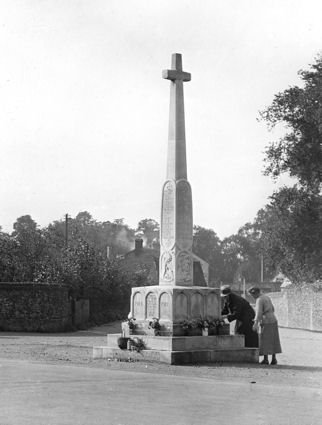W.E. Dring, 1974
This is the second part of a series of reminiscences of Trumpington in the 1920s. For an introduction to the series, see Trumpington Fifty Years Ago: Reminiscences of the 1920s.
Trumpington Church School and Celebrations

The village elementary school, as it was then called, still stands opposite the entrance to Anstey Hall but it is no longer used as a school. It consisted, when in use, of the main room where Mr Robinson, the headmaster, taught, assisted by one teacher. A smaller room, divided from the first by a folding partition, was supervised by a rather dragon-like mistress named Miss Funge, while a small room at the rear was for the infants. The infant teacher was an elderly motherly teacher named Miss Marshall, who usually arrived late in the mornings as she had to walk from North Cottages on the Cambridge Road. If by chance we found that we were likely to be late ourselves we used to wait for Miss Marshall and arrive under her wing as it were, thus avoiding any punishment for lateness. Incidentally Mr. Robinson was a firm but popular teacher who used the cane when he thought it necessary without as far as I know any of the recipients being permanently warped thereby. There was of course, no school meals or school transport in those days. Everyone walked to school, except the fortunate one or two who had bicycles. Boys then wore shorts until they were nearly fourteen and I cannot remember that we suffered from the cold even in the coldest weather. There were no Wellington boots in those days but I remember wearing leather leggings when the snow was on the ground. On two afternoons a week, the older boys did woodwork and gardening while the girls did needlework and knitting. As I left at the age of ten to go to the Perse School with one of the scholarships provided by Thomas Hobson, the famous carrier of Cambridge, I did not get the opportunity to do any gardening or woodwork. I have the impression that the standard of reading was higher then than it is in similar schools today. At the age of eight and nine we were reading in class Kingsley’s Hereward the Wake and Westward Ho and Fenimore Cooper’s Nat the Naturalist . It was about that time that I remember the first box of books arriving from the County Library. They were a rather dull lot by today’s standards, but we fell on them with avidity.
May Day and Empire Day were always celebrated. A maypole was erected on the crossroads outside the school (traffic was few and far between then) and selected pupils danced round it for the entertainment of parents and friends. On Empire Day – curiously enough we were rather proud of the British Empire then – we all paraded on the same spot, solemnly saluted the Union Jack flying at the flagpole and sang patriotic hymns and songs such as Kipling’s Recessional . We were then each given a bun, an orange and a bag of sweets and the rest of the day for a holiday.
In Grantchester Lane between the school and Cross Hill on the main road, where the War Memorial stands, is a public house called The Unicorn . In one of the outbuildings of this a fried fish shop operated on several evenings a week. A piece of fish then cost 2d, and chips to match, 1d.
On the main road opposite the War Memorial stands The Red Lion , but the present building is comparatively modern. When the old building stood there, there was a lane running down beside it to a small meadow at the rear. This was the site of the village Feast which lasted for three days and took place in summer, the week after the Midsummer Fair in Cambridge. It invariable consisted of one large roundabout operated by the great traction engine which pulled the vans, one of a type which has now vanished from the roads. The music was supplied by a steam organ decorated with the moving figures of gods and goddesses. Later this music was replaced by amplified music from records which did not have the old magic of the organ. There were swings, coconut shies and skittle alleys, dart saloons and a shooting gallery. There were rock stalls, at one of which you could watch the rock being made before you bought it, cockle and whelk stalls and occasionally a man selling solid gold watches for ten shillings each! One year a boxing booth appeared and was very popular, another year a cabaret show ‘direct from Paris’.
When The Red Lion was rebuilt it blocked the lane and as there was no other place for it, the old Feast died. Now the blaze of lights in the summer night, the sound of the organ, the clang of the bullets on the steel plate of the shooting gallery, the mingled smell of rock, whelks and the naphtha flares are things of the past. In those days the Feast was an event to be anticipated and saved for. A trip on the roundabout cost 2d, the swings, 1d, and the skittles, 2d for three balls.
Just down Grantchester Lane on the left, past a row of old cottages, was a triangular piece of land reputed to have once been the site of a witch’s cottage. She was supposed to have cursed the land when she died and certainly I don’t remember a good crop of anything being grown on it.
Continue with the next part of W.E. Dring’s reminiscences of Trumpington in the 1920s.